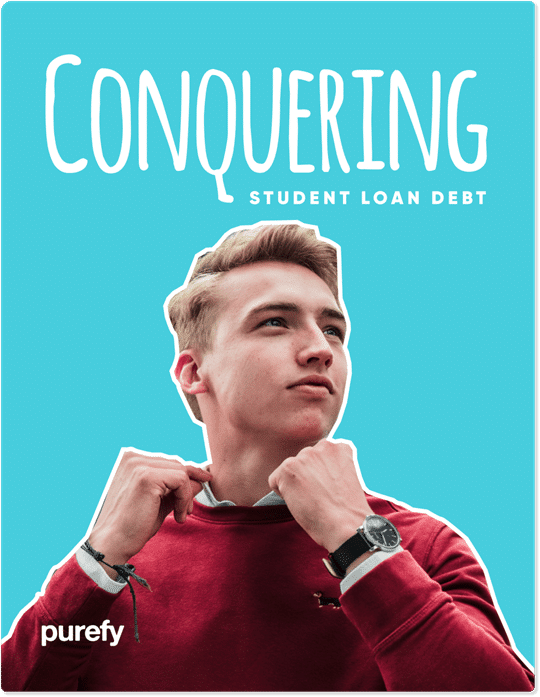When you were in college, did you exhaust your scholarships, grants, and gifts early on?
Like many people, you may have taken out student loans to help bridge any shortages. Now you are dealing with both federal and private student loan debt and may be looking to simplify your finances. You’re not alone!
In 2021, 62% of graduates left school with substantial student debt. People with an undergraduate degree have an average total debt of just under $30,000. And for those with graduate degrees, the number more than doubles.
That adds up to over $1.6 trillion in federal and private student loans in the US — that’s greater than the nation’s total credit card debt and it’s concentrated within a much smaller group.
What can you do to ease the burden?
There are several options to help ease the burden and pay down your federal and private student loan debt — consider:
- Use extra cash towards lowering your student debt. When you receive a windfall, use that extra money towards paying student loans. Your tax refund, a sign-on bonus for a new job, or an inheritance from a distant aunt can all be ways to pay down your debt.
- Part-time work like driving or delivering, independent contractor work, or tutoring can get you extra money to pay down your loans.
- Pay more with each payment. An extra $100 per payment can reduce the time it takes to pay off your loans and there are no pre-payment penalties attached to student loans.
- Refinance your federal and private loans into one combined loan and save money with a lower interest rate. This may be your best bet since lower interest means a lower monthly payment.
What does combining private and federal student loans mean?
Federal student loans are loans where you or your parents borrowed money from the government. Federal loans have terms and conditions that are defined by law through Congress and are guaranteed by the Department of Education.
They are easy to get since you don’t need to show a credit report and the interest rate has been set at a manageable rate over the years.
With private loans, you or your parents may have approached a bank, credit union, or other private lender to get supplemental student loans that could be used for tuition, books, housing, living expenses, etc.
There are two ways to combine your student loans. First, you can use a private lender to refinance your federal and private student loans, which combines all of your loans into one consolidated loan with a new, and hopefully lower, interest rate.
Or you can consolidate your federal loans into one loan through a direct consolidation plan. Your new loan will have an average interest rate of all your individual loans, which won’t save you any money in the long run. Plus, you still have all the private loans which can’t be included in a federal consolidation plan.
How can you combine private and federal student loans?
To combine all your private and federal student loans together into one simple loan instrument, private lenders offer refinancing loans. Once you apply for a refinance and are accepted, your new lender will pay off your current loans and expect you to pay on a new loan directly to them.
These loans are offered at the current agreed-upon interest rate which has been at historic lows for some time and can save you money on your monthly payments.
To refinance through a private lender, you (or your parent for Parent PLUS loans) will need to have adequate resources and credit to be approved. Unlike federal student loans, these loans are not guaranteed by the federal government, so private lenders will do their due diligence to make sure that you are likely to be able to repay the loan.
The 2 Best Companies to Refinance Student Loans
Our Top-Rated Picks for 2024 Offer Low Rates and No Fees

What does that mean?
To be approved for a private loan, each lender will have different parameters to gauge your creditworthiness — however, these things will definitely be part of the overall considerations:
- Your creditworthiness which is demonstrated through your credit score and credit history. Yes, someone has kept track of every financial commitment you have made, and every payment received. If you don’t know what your credit score is or what specific items are on your credit report, be sure to obtain your free annual report from all three agencies here.
- Your ability to repay the loan which will be based on two things:
- Income — can you demonstrate sustainable, ongoing income either through a job where you receive a paycheck or 1099 or as a business owner where your income is reported on your tax return, and
- Your debt-to-income ratio or DTI, which finds the percentage of your income that goes toward paying your fixed expenses (e.g., rent or mortgage, credit card minimums, loan payments, etc.). Try the calculator here to find your DTI and remember, lenders are looking for a DTI less than 38% as a general rule.
- The college you attended and the degree you received.
If for some reason your current financial situation doesn’t make the grade, you can always consider finding a cosigner, like a parent or grandparent, since many private lenders will refinance student loans with a cosigner that meets their financial criteria.
Why combine private and federal student loans?
So, you may be thinking why bother combining your student loans? The answer is a simple one — because it can save you money!
When you refinance, you are taking all of your different federal and private student loans and combining them into one package with a new interest rate. Since there is no obligation to explore what amount of interest you may qualify for, the best option is to do some research by checking with a number of reputable lenders…more about that later.
Is now a good time to refinance?
Currently interest rates are at all-time lows. The Central Bank (the Fed) has signaled that they are going to raise rates to combat inflation over the next year or two. The first hike or two are expected to be between 0.25% and 0.50% which will likely still leave interest rates lower than they have been historically.
With possible increases coming soon, now is a particularly good time to institute a refinance.
How much savings are we talking about?
Well, let’s look at an example:
Let’s say you have $40,000 in student loans currently and are paying an average of 7.1% in interest for 10 years. That means that you will have monthly payments of $466.50. It also means that you will pay almost $16,000 in interest over the life of your loans.
Now let’s say that you refinance that same $40,000 for 10 years, but at an interest rate of 3.2%. Your monthly payment drops to $389.95 per month (over $980 a year) and you only pay $6,793.61 in total interest.
Who can’t use an extra $1,000 per year in the bank?
See How Much You Can Save
View Details
Collapse
Step 3: See How Much You Can Save
$15,310
Lifetime Interest
Savings
$1,018
New Monthly
Payment
$128
Monthly
Savings
| Current Loan | New Loan | Savings | |
|---|---|---|---|
| Rate | 6.7% | 4.2% | 2.5% |
| Lifetime Interest | $37,520 | $22,210 | $15,310 |
| Monthly Payment | $1,146 | $1,018 | $128 |
Like what you see? Check your actual prequalified rates from the industry’s top lenders in just 2 minutes or less.
Other pros of refinancing student loans
In addition to saving money on interest, you can also gain some of these benefits when refinancing – depending on your situation.
Pay off your loans sooner
You may be in a position to pay off your loans sooner. Maybe you want to buy a house or are planning to get married and you want to finish repaying your student loans as quickly as possible.
When refinancing, you have the option to select flexible terms for repayment. Some lenders offer terms for 5 or 7 years instead of the traditional 10 years that dictate federal loan terms.
The downside can be that your monthly payments will be larger when you shorten your loan term. However, the good news is you will save even more in interest over the life of the loan.
Reduce your monthly payment amount
When refinancing, you also have the option to extend your terms with some lenders offering 20 and even 25-year terms.
From our example above, if you were to choose a 20-year term to repay your $40,000 student loan at 2.89% interest, your monthly payments would drop to $225.87 per month. And because of the lower interest rate, you still save money – your total interest would be $14,207 (a savings of about $1,800).
Adding or removing a cosigner
Having someone cosign a loan is a great way to establish credit and have the ability to borrow at the same time.
If you don’t meet the credit requirements we discussed above, then using a cosigner allows you to ‘borrow’ their creditworthiness while you work to build your own history. Often that person is a parent or grandparent who not only is vouching for you, but also impacting their own credit history and ability to borrow.
If you need a cosigner to refinance your private and federal student loans, most lenders allow you to apply with one, although a few don’t — so be sure to check.
If you currently have a cosigner on one or more loans but are now in a better place financially and ready to take on the responsibility singlehandedly, refinancing is a great way to bring the debt under your name alone and free up your cosigner. This allows you to build credit history in your own name unencumbered and give your cosigner the peace of mind and financial flexibility they need.
As a side note, if you require a cosigner to refinance your loans, some companies offer a cosigner release that allows you to fully assume responsibility after you have made 12-24 monthly payments in good standing.
Consolidate and simplify
By consolidating your federal and private loans into a single loan you can simplify your monthly finances.
Are you currently paying multiple monthly payments with different due dates, loan processors, and amounts? When you refinance, all of those loans are paid off and you then make one simple payment to a new lender — one payment per month, one amount, one check to write or automatic withdrawal to manage.
Who doesn’t want a more streamlined financial process?
No fees to refinance
One more benefit that we don’t want to forget about — there are no fees to refinance. Unlike the home mortgage refinance marketplace, student loan lenders don’t charge application fees or origination fees to refinance student loans.
There are no pre-payment penalties either. That means you can pay your loan off early or refinance again at a later date and not have to pay any early payoff fees.
Potential drawbacks when refinancing student loans
While it’s good to understand all the benefits of refinancing, you also want to contrast those with the benefits that you will potentially lose. To make an informed decision, consider these things:
You may not be eligible
When refinancing, you may simply not be eligible for refinancing or have a willing cosigner. It’s always possible that your credit score is too low, or you don’t have enough income which can negatively impact your DTI, as well as your ability to repay the loan in the eyes of the lenders.
Don’t lose heart — there are things you can do to improve your score and your income so that you can take advantage of refinancing options.
Loss of federal loan benefits
For federal loans, when you refinance with a private lender you will lose any access to federal benefits, such as the ability to participate in their generous payment plans, including:
- Income-driven repayment programs — federal loans are eligible for one of four income-driven repayment plan options. Each caps your monthly payments at a percentage of your expendable income and has a 20- or 25-year repayment term. Once you have met that obligation, you can apply for all remaining balances to be forgiven.
Before you consider this as a potential drawback, note that the National Consumer Law Center has determined that only 32 borrowers have received any loan cancellations. While this law was enacted over 25 years ago (1995), people are just now reaching the eligibility timeframe to apply for forgiveness and are finding it is being denied.
- Federal deferment and forbearance programs and consolidation plans — federal loans can be eligible for payment suspension or abeyance. Something to note: many private lenders also offer deferment options as well.
- Other forgiveness options that would include the Public Service Loan Forgiveness Plan (PSLF), Teacher Loan Forgiveness, and student loan forgiveness for graduates of nursing programs.
- Loan discharges due to permanent disability or death unless offered by your new lender.
Be sure to weigh the pros and cons of refinancing federal student loans before applying.
Loss of your grace period
If you are within six months of graduation, you may have opted for exercising your grace period before federal loans become due. When you refinance, you lose any remaining time of your grace period.

Free eBook: How to Conquer Student Loans
Free eBook: How to Conquer Student Loans

How to decide if it’s a good idea to refinance your student loans
Start at the beginning — determine your credit score (670 or above is usually required for most private lenders, but 700s or 800s is even better), your income-based DTI, and the total amount of loans and interest you are currently paying.
Next, take a look at how a change in interest rates will impact your monthly payment and your total interest due for the life of your loan. You can find automated calculators for everything from student loan refinance rates to DTI here.
With that information, it’s time to compare student loan interest rates from among a group of private lenders.
How to compare today’s student loan refinance rates
Rather than have to go to each lender’s website and research their current daily rates and various terms, Purefy has developed a quote aggregating engine that collects everything you need. It quite literally answers your questions about can you combine private and federal student loans, and do you even want to pursue it?
To do a quick automated comparison (takes about two minutes), you will need to prepare the following information. Hopefully, most of this is at your fingertips:
- your annual income,
- the total amount due from all your federal and private student loans,
- some basic demographic information – citizenship, date of birth, and your SSN,
- whether you rent or own your home,
- the school you graduated from, and
- your graduation date and degree.
From this information, you’ll receive pre-qualified quotes from lenders where you may qualify. These quotes will include the fixed and variable (if offered) interest rates, your term options, and any special offers or considerations.
Now, you need to compare the information and make a decision based on your refinancing position and possible savings. The quotes are non-binding, as well as free, and they won’t affect your credit score since any inquiries about your credit history at this point are considered informal.
When you decide to create and submit a formal application, the lender you select will perform a thorough credit check which will show on your credit report for several years.
To wrap up
So, can you combine private and federal student loans into one refinanced loan package? Yes!
Now you know the benefits and the potential drawbacks you may encounter when you combine your loans together. The good news is there’s no fees or obligations to research all of your options and there are plenty of great tools and calculators to help you take a thorough look.
If you have a strong credit history and sustainable income, now is a great time to do your research and make a choice to save money. Interest rates are set to start climbing through 2022 and 2023, so don’t be caught short in six months or a year when it may be more expensive to refinance your student loans.
If you have federal and private student loans, refinancing combines your debt into one easy loan with other financial benefits. Contact us at Purefy to learn more or to jump right in by using our Compare Rates Tool. It takes about two minutes to gather lenders with pre-approved quotes and barely 15 minutes to actually apply for a new refinanced student loan.



















